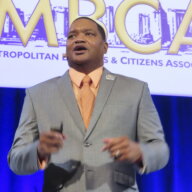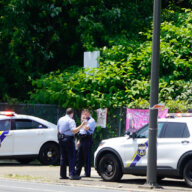Philadelphia’s zoning code drama dragged on yesterday as public testimony wrapped up in City Council. About 20 residents from Southwest Philadelphia gathered in the back of the room and held signs protesting a planned halfway house — technically called a re-entry facility, but which they called a “private prison” — in Grays Ferry.
“If you take a prison and inject it into any area, it’s going to be like putting a cat in a room full of rats,” said self-identified community representative James Harrison, who testified on behalf of the Southwest Coalition of Community Neighborhoods. “Everyone else is going to scurry away.”
Members often became restless. One woman interrupted the meeting with a cry of: “Don’t forget about us, Jannie!”
The response seemed to catch Councilwoman Blackwell off guard.
“We have been very pleased with the progress and held zoning code meetings in my area,” she said. “I was surprised when community members who attended these local meetings had questions.”
“I am concerned that the zoning code would reduce the amount of variance, but not require developers to provide community notification on other issues.”
Though the debate is not new — residents protested in February after the planned facility won a five-year zoning board approval — new language in the proposed zoning code would make this kind of development easier to build and harder to fight.
No buffer for re-entry facilities
The current zoning code puts re-entry facilities in the same class as prisons, which are prohibited from locating within 500 feet of a residential neighborhood. The new zoning code would create a separate category for re-entry facilities not subject to the same buffer.
“Prison halfway houses produce nothing and buy very little from the local economy,” said advocate Lillian Davis. “It’s not right. Us old people, we make the community. Why should we have to suffer for these prisoners who broke the law?”






























